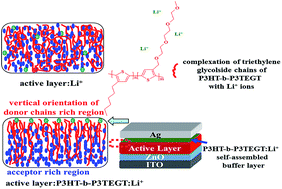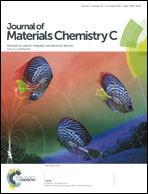Self-assembled buffer layer from conjugated diblock copolymers with ethyleneoxide side chains for high efficiency polymer solar cells†
Abstract
In this article, we present a novel and promising approach to enhance the device performance and stability by the simple incorporation of all conjugated polythiophene diblock copolymers, poly(3-hexylthiophene)-b-poly(3-triethylene glycol thiophene) (P3HT-b-P3TEGT), into the active layer based on inverted device structures. During the spin-coating process, the triethylene glycol side chains of P3HT-b-P3TEGT would spontaneously migrate vertically towards the active layer surface and form a nanoscale self-assembled anode buffer layer, which simultaneously drives the orderly packing of donor polymer chains and vertical phase separation morphology, allowing electrons and holes to move more efficiently to the respective electrode. Moreover, the nanoscale self-assembled buffer layer can form interfacial modification and ohmic contact between the active layer and Ag (or MoO3/Ag) electrode, reduce the contact resistance of the device, and increase the electrical conduction of the device, especially upon chelating lithium ions (Li+) to the triethylene glycol side chains of P3HT-b-P3TEGT. Combining the above advantages, the efficiency and stability of the polymer solar cells are enhanced. A remarkable improvement in the PCE with 7.3% (measured in air) is obtained for PBDTTT-C-T:PC71BM devices.

- This article is part of the themed collection: 2014 Journal of Materials Chemistry C Hot Articles

 Please wait while we load your content...
Please wait while we load your content...